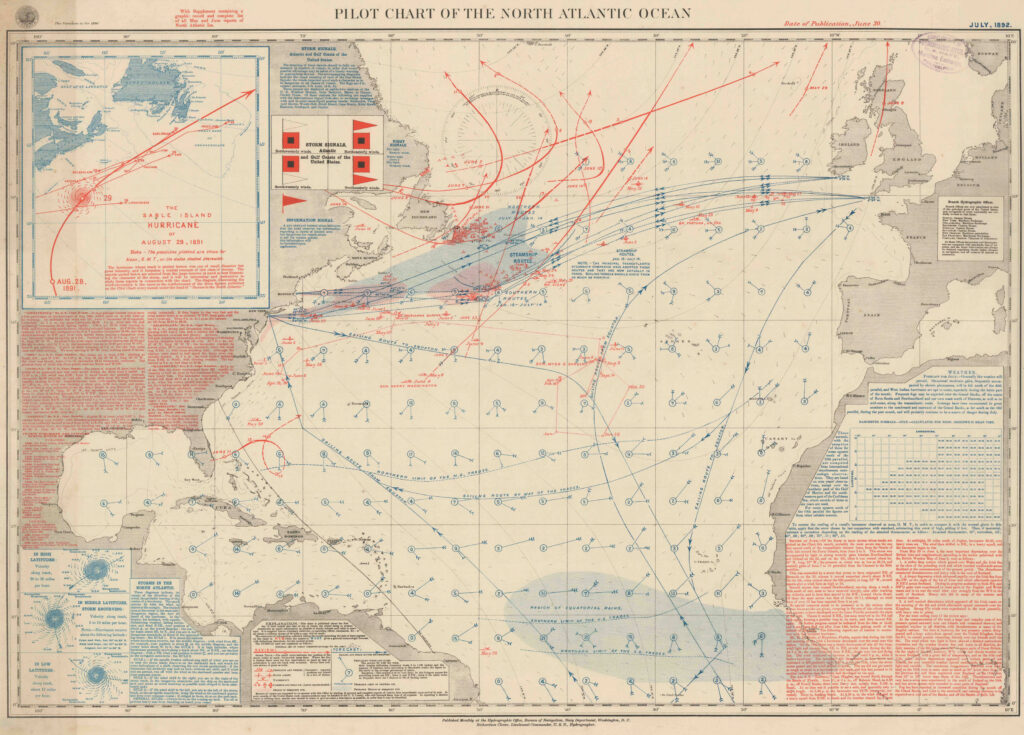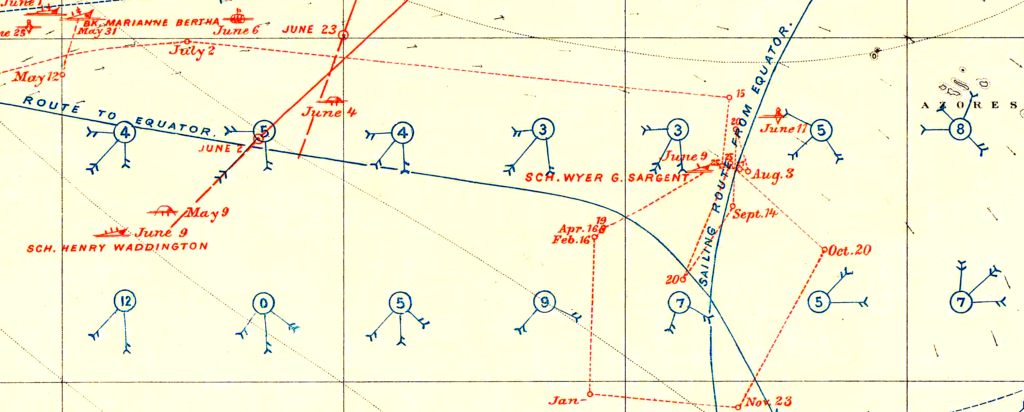© Copyright 2023 by Dr. E. Lee Spence
Spence is @ShipwrecksGuru on both Instagram and “X” (formerly “Twitter”)

A Shipwrecked Schooner Finally Goes Ashore on Conception Island, Bahamas — After a career unparalleled in the history of maritime affairs, the derelict schooner Wyer G. Sargent, wrecked and abandoned at sea March 31, 1891, off Cape Hatteras, while bound to New York “with a cargo of lumber — her crew being rescued by the schooner H.E. Thompson — after battling with the storms of the Atlantic for nearly six years, has drifted ashore on the uninhabited island of Conception, one of the most dangerous of the Bahamas, and there will end her days. She is shattered and covered with barnacles. Her cargo of lumber long ago has been emptied into the sea through her capsizing, but her stout hull is still held together as firmly as the day she was launched at Sedgwick, Maine, in 1861. — This most remarkable career just ended has for years past attracted the attention of shipping men all over the world, as her erratic courses about the Atlantic were for months most accurately plotted on the pilot charts issued by the hydrographic department at Washington. Her drift was indeed more singular than that of the famous old schooner W.L. White, which although abandoned in the same locality, drifted ashore ten months afterward at the Hebrides Islands, off the northwest coast of Scotland. — The Sargent in about three months from the date of her abandonment reached the center of the North Atlantic. Here she drifted about in a most peculiar and erratic manner for some time until October 12, 1892, when she got into the Sargasso Sea, and experienced shipmasters do not doubt that in this sea she remained until carried out of its influence by unusually fierce easterly gales this last winter. — The theory is that the Sargent, after being freed from the Sargasso Sea, came down to the southward and westward with the trade winds and currents, as did several other derelicts. — Philadelphia Press.”
According to the Record of American and Foreign Shipping, the American three-masted schooner Wyer G. Sargent, official number 80855, signal letters JVPG, Captain Sargent, was built/launched in November of 1881 at Sedwick, Maine, which was also her hailing port. At that time, she was owned by William D. Gower. She was 309 tons and measured 131.3 feet in length, 31.9 feet in breadth, and 11.2 feet in depth. She was constructed of mixed woods fastened with iron and copper, and had a center-board. When surveyed at New York in July of 1790 she was classed A 1.

The above illustration is an excerpt from the 1892 Pilot Chart for the month of July. It used an orange dotted line to show the track of the schooner Wyer G. Sargent.
Note by ELS: The public first learned of the abandonment of this schooner through one or two-line reports, such as this note in The Boston Post in April of 1891, which stated “schooner Wyer G. Sargent, from Laguna for New York, was abandoned off Hatteras about March 30. Crew landed at Neuvitas.” The public had no idea they would be reading about this vessel periodically for years to come, as she continued to float and drift along in the Atlantic. This report was published in the Baltimore Sun, in April, of 1891, and was another of the early accounts of her being abandoned “A letter received at Havana, Cuba, yesterday, from Neuvitas, under the date of April 10, contains the information that an American schooner Wyer G. Sargent, Captain Danse, which foundered while on a voyage from Campeachy for New York. The many reports of sightings of the derelict schooner that followed were often like this one, but giving different coordinates. “the ship Belle O’Brien, at New York, April 15, reports that on April 12 in latitude 35°40′ North, longitude 72°10′ West, passed the wreck of the schooner Wyer G. Sargent, with masts gone, mainmast lying on the rail, foremast hanging by the headstays, overboard.” A more interesting account, at least to me, was the following one, which was published in the Boston Evening Transcript in the summer of 1891, and stated “The ocean tug Britannia is engaged in a chase after a Maine vessel that is floating on the ocean with $20,000 worth of mahogany in her cargo hold [which would have cost over 100 times that in today’s dollars]. That vessel is the Wyer G. Sargent, owned by William G. Gower of Sedwick and abandoned in a storm last March when about eighty miles off Hatteras. Since then she has drifted over two thousand miles, crossing the Gulf Stream three times. At one period of her wild cruise she went 500 miles in twenty-two days. When last sighted, a part of the cargo was yet on board.” In the days before radar, with perimeter alarms, derelicts presented a serious danger to navigation. So, starting in 1883, the U.S. Navy Hydrographic Office, Bureau of Navigation, Navy Department, in Washington DC, published monthly Pilot Charts, which tracked the drifts of derelict sailing vessels and other drifting debris that could present a hazard to navigation in the North Atlantic. Just between the start of this service in 1887 and the end of 1893, over 1,600 derelict sightings were recorded. Two hundred of these derelicts being identified by name. It was the aid of those charts that are referred to in this brief article, which was published in April of 1893. “The ocean mariner dreads a derelict, and is greatful when our government gets fresh track of one of these dangerous old vagrants and tells the marine world about where she drifts. There is one ship thus wandering around that has become famous. She is the American schooner Wyer G. Sargent, abandoned March 31, 1891, laden with twenty thousand dollars’ worth of mahogany. She was from Mexico bound for New York. She has already drifted, since being abandoned off Cape Hatteras, over five thousand miles.”
Note regarding sources: Please cite this page as follows: Spence, E. Lee. “Six Years Adrift.” Shipwrecks.com, 12 October 2023, https://www.shipwrecks.com/six-years-adrift/ (be sure to substitute your date of access, as this helps when edits & updates are made)
The above text has been taken from my upcoming book, Shipwrecks of the Old Bahama Islands, 1500-2021, which is already well over 5,500 pages with almost 16,000 footnotes. It has taken me decades to compile it and is part of a growing series of books that I have authored over the years, and will be republished under the collective title of Encyclopedia of Shipwrecks — Spence’s List™. All are currently out of print, but will be soon be available in a print on demand format. Like this website, my book will be copyrighted for both composition and compilation, with all rights reserved. The footnotes for this page have been removed, so others will properly credit this webpage as their source, rather than just listing my footnotes as though it is their own work. For researchers needing more information, my footnotes can be purchased for a nominal fee.
If you are interested in learning more about my work, please visit https://shipwrecks.com/about-spence/